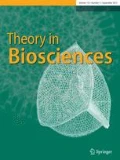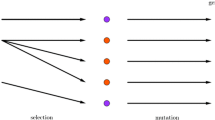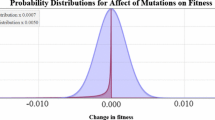Abstract
We systematically investigate the Wright–Fisher model of population genetics with the free energy functional formalism of statistical mechanics and in the light of recent mathematical work on the connection between Fokker–Planck equations and free energy functionals. In statistical physics, entropy increases, or equivalently, free energy decreases, and the asymptotic state is given by a Gibbs-type distribution. This also works for the Wright–Fisher model when rewritten in divergence to identify the correct free energy functional. We not only recover the known results about the stationary distribution, that is, the asymptotic equilibrium state of the model, in the presence of positive mutation rates and possibly also selection, but can also provide detailed formulae for the rate of convergence towards that stationary distribution. In the present paper, the method is illustrated for the simplest case only, that of two alleles.
Similar content being viewed by others
Notes
We should point out an essential incompatibility between the mathematical and the biological terminology here. Mathematically, in a Fokker–Planck-type equation, the leading part which contains second derivatives w.r.t. the spatial variables is called the diffusion part, and an additional first term, which may or may not be present, is called a drift term. In the biological model, random genetic drift, which is the most important component of the Wright–Fisher model, causes the diffusion, and not the drift term in the Fokker–Planck equation.
References
Arnold A, Markowich P, Toscani G, Unterreiter A (2001) On convex Sobolev inequalities and the rate of convergence to equilibrium for Fokker–Planck type equations. Commun Partial Differ Equ 26(1–2):43–100
Calogero S (2012) Exponential convergence to equilibrium for kinetic Fokker–Planck equations. Commun Partial Differ Equ 37(8):1357–1390
Carrillo JA, Toscani G (1998) Exponential convergence toward equilibrium for homogeneous Fokker–Planck-type equations. Math Methods Appl Sci 21(13):1269–1286
Chalub FACC, Souza MO (2014) The frequency-dependent Wright–Fisher model: diffusive and non-diffusive approximations. J Math Biol 68(5):1089–1133
Desvillettes L, Villani C (2001) On the trend to global equilibrium in spatially inhomogeneous entropy-dissipating systems: the linear Fokker–Planck equation. Commun Pure Appl Math 54(1):1–42
Desvillettes L, Villani C (2005) On the trend to global equilibrium for spatially inhomogeneous kinetic systems: the Boltzmann equation. Invent Math 159(2):245–316
Ethier SN, Norman MF (1977) Error estimate for the diffusion approximation of the Wright–Fisher model. Proc Nat Acad Sci USA 74(11):5096–5098
Ewens WJ (2004) Mathematical population genetics. I, 2nd ed, vol 27. Interdisciplinary Applied Mathematics. Theoretical introduction. Springer, New York
Hérau F, Nier F (2004) Isotropic hypoellipticity and trend to equilibrium for the Fokker–Planck equation with a high-degree potential. Arch Ration Mech Anal 171(2):151–218
Hofrichter J, Jost J, Tran TD (2015) Information geometry and population genetics
Houchmandzadeh B, Vallade M (2010) Alternative to the diffusion equation in population genetics. Phys Rev E 82:051913
Houchmandzadeh B, Vallade M (2015) Exact results for a noise-induced bistable system. Phys Rev E 91:022115
Ikeda N, Watanabe S (1981) Stochastic differential equations and diffusion processes, vol 24. North-Holland Mathematical Library. North-Holland Publishing Co., Amsterdam-New York; Kodansha, Ltd., Tokyo
Iwasa Y (1988) Free fitness that always increases in evolution. J Theor Biol 135(3):265–281
Jordan R, Kinderlehrer D, Otto F (1997) Free energy and the Fokker–Planck equation. Phys D 107(2–4):265–271
Levikson B (1977) The age distribution of Markov processes. J Appl Probab 14(3):492–506
McKane A, Waxman D (2007) Singular solutions of the diffusion equation of population genetics. J Theor Biol 247(4):849–858
Nagasawa M, Maruyama T (1979) An application of time reversal of Markov processes to a problem of population genetics. Adv Appl Probab 11(3):457–478
Tran T, Hofrichter J, Jost J (2013) An introduction to the mathematical structure of the Wright–Fisher model of population genetics. Theory Biosci 132:73–82
Tran TD, Hofrichter J, Jost J (2015) A general solution of the Wright–Fisher model of random genetic drift. (submitted)
Tran TD, Hofrichter J, Jost J (2015) The free energy method for the Fokker–Planck equation of the Wright–Fisher model (preprint)
Watterson GA (1977) Reversibility and the age of an allele. II. Two-allele models, with selection and mutation. Theor Popul Biol 12(2):179–196
Acknowledgments
We are grateful to Yoh Iwasa for drawing our attention to Iwasa (1988). We also thank two anonymous referees for their constructive and useful suggestions to improve the first version of this paper. The research leading to these results has received funding from the European Research Council under the European Union Seventh Framework Programme (FP7/2007-2013)/ERC grant agreement no. 267087.
Author information
Authors and Affiliations
Corresponding author
Rights and permissions
About this article
Cite this article
Tran, T.D., Hofrichter, J. & Jost, J. The free energy method and the Wright–Fisher model with 2 alleles. Theory Biosci. 134, 83–92 (2015). https://doi.org/10.1007/s12064-015-0218-2
Received:
Accepted:
Published:
Issue Date:
DOI: https://doi.org/10.1007/s12064-015-0218-2




